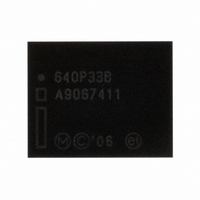PC28F640P33B85A NUMONYX, PC28F640P33B85A Datasheet - Page 44

PC28F640P33B85A
Manufacturer Part Number
PC28F640P33B85A
Description
IC FLASH 64MBIT 85NS 64EZBGA
Manufacturer
NUMONYX
Series
StrataFlash™r
Datasheet
1.PC28F640P33B85A.pdf
(96 pages)
Specifications of PC28F640P33B85A
Format - Memory
FLASH
Memory Type
FLASH
Memory Size
64M (4M x 16)
Speed
85ns
Interface
Parallel
Voltage - Supply
2.3 V ~ 3.6 V
Operating Temperature
-40°C ~ 85°C
Package / Case
64-TBGA
Cell Type
NOR
Density
64Mb
Access Time (max)
85ns
Interface Type
Parallel/Serial
Boot Type
Bottom
Address Bus
22b
Operating Supply Voltage (typ)
2.5/3/3.3V
Operating Temp Range
-40C to 85C
Package Type
EZBGA
Sync/async
Async/Sync
Operating Temperature Classification
Industrial
Operating Supply Voltage (min)
2.3V
Operating Supply Voltage (max)
3.6V
Word Size
16b
Number Of Words
4M
Supply Current
28mA
Mounting
Surface Mount
Pin Count
64
Lead Free Status / RoHS Status
Lead free / RoHS Compliant
Other names
888226
888226
PC28F640P33B85
PC28F640P33B85 888226
888226
PC28F640P33B85
PC28F640P33B85 888226
Available stocks
Company
Part Number
Manufacturer
Quantity
Price
Company:
Part Number:
PC28F640P33B85A
Manufacturer:
Micron Technology Inc
Quantity:
10 000
9.4
9.5
Note:
9.6
Datasheet
44
Standby
When CE# is deasserted the device is deselected and placed in standby, substantially
reducing power consumption. In standby, the data outputs are placed in High-Z,
independent of the level placed on OE#. Standby current, I
measured over any 5 ms time interval, 5 μs after CE# is deasserted. During standby,
average current is measured over the same time interval 5 μs after CE# is deasserted.
When the device is deselected (while CE# is deasserted) during a program or erase
operation, it continues to consume active power until the program or erase operation is
completed.
Reset
As with any automated device, it is important to assert RST# when the system is reset.
When the system comes out of reset, the system processor attempts to read from the
flash memory if it is the system boot device. If a CPU reset occurs with no flash
memory reset, improper CPU initialization may occur because the flash memory may
be providing status information rather than array data. Flash memory devices from
Numonyx allow proper CPU initialization following a system reset through the use of the
RST# input. RST# should be controlled by the same low-true reset signal that resets
the system CPU.
After initial power-up or reset, the device defaults to asynchronous Read Array mode,
and the Status Register is set to 0x80. Asserting RST# de-energizes all internal
circuits, and places the output drivers in High-Z. When RST# is asserted, the device
shuts down the operation in progress, a process which takes a minimum amount of
time to complete. When RST# has been deasserted, the device is reset to
asynchronous Read Array state.
If RST# is asserted during a program or erase operation, the operation is terminated
and the memory contents at the aborted location (for a program) or block (for an
erase) are no longer valid, because the data may have been only partially written or
erased.
When returning from a reset (RST# deasserted), a minimum wait is required before the
initial read access outputs valid data. Also, a minimum delay is required after a reset
before a write cycle can be initiated. After this wake-up interval passes, normal
operation is restored. See
about signal-timing.
Device Command Bus Cycles
Device operations are initiated by writing specific device commands to the CUI. See
Table 23, “Command Bus Cycles” on page
array data including Word Program and Block Erase commands. Writing either
command to the CUI initiates a sequence of internally-timed functions that culminate in
the completion of the requested task. However, the operation can be aborted by either
asserting RST# or by issuing an appropriate suspend command.
Section 7.0, “AC Characteristics” on page 29
45. Several commands are used to modify
Numonyx™ StrataFlash
CCS
, is the average current
®
Embedded Memory (P33)
Order Number: 314749-05
for details
November 2007












